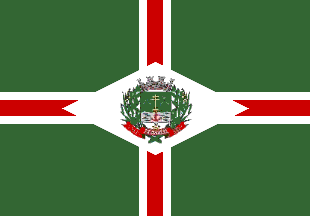 image by Blas Delgado Ortiz
image by Blas Delgado Ortiz
Last modified: 2020-07-25 by ian macdonald
Keywords: brazil | rio grande do sul | itaqui | lozenge | cross | cross (double barred) | anchor | swords |
Links: FOTW homepage |
search |
disclaimer and copyright |
write us |
mirrors
According to
ns1.itaqui.com.br/itaqui/historico.html, the name of Itaqui means in the Guarani Indian language
a smooth rock from the water, one that is good for sharpening things. That seems to be the symbolism of the
crossed sabers in the coat of arms and of the water in the base. In addition, the town grew up around a
Jesuit mission called Rincão da Cruz, accounting for the cross in the coat of arms.
Source:
ns1.itaqui.com.br/itaqui/simbolos.html.
Joseph McMillan, 17 March 2002
The municipality of Itaqui (39,049 inhabitants in 2016; 34,040 ha) is located
680 km north-west of Porto Alegre, on the border with Argentina, here river
Uruguay.
The municipality was established by State Law No. 419
promulgated on 6 December 1858, separating from São Borja.
The Prezewodowski
Theater, built in 1883, and named for Estanislau Prezewodowski (1864-1870), the
captain who commanded the Alto Uruguai War Flotilla, is among the oldest
theaters in South America.
http://www.itaqui.rs.gov.br/
Municipal website
Ivan Sache, 19 July 2020
The flag and arms to Itaqui, which were designed by the heraldist Arcinôe
Antonio Peixoto de Faria, are prescribed by Municipal Law No. 984 promulgated on
25 November 1958.
In compliance with the Portuguese heraldic traditions,
and their inherited canons and rules, the flag is quartered by a cross
symbolizing the people's spirit and Christian origin. The coat of arms applied
on the flag represents the municipal government while the white lozenge
represents the town as the municipal seat. White is a symbol of peace,
friendship, work, property, purity and religious feeling. The white stripes
charged with red stripes quartering the flag represent the spread of municipal
power all over the territory. Red is a symbol of dedication, patriotic love,
audacity, intrepidity, courage and valiance. The green quarters represent the
rural estates scattered over the municipal territory. Vert is a symbol of honor,
civility, courtesy, glee, and abundance; green is also the symbol of hope, as
the greening fields in spring promising profuse harvests.
The coat of
arms keeps the essential elements of the former coat of arms, which was
prescribed by Municipal Law No. 324 promulgated on 25 November 1958.
A
Samnite shield surmounted by a six-towered mural crown argent ports gules. Vert
an Episcopal Cross of Lorraine or surrounded by swords argent crossed per
saltire. A base argent wavy vert superimposed by an anchor gules fouled argent.
The shield surrounded dexter and sinister by soybean and rice plants proper
crossed in base and superimposed by a scroll gules containing in letters argent
the toponym "ITAQUI" surrounded by the years "1837" and "1858". Hanging from the
shield's point a hunting horn or."
http://www.camaraitaqui.rs.gov.br/?action=itaqui_simbolos
Municipal
website
Photos
http://www.itaqui.rs.gov.br/
https://media-cdn.tripadvisor.com/media/photo-s/13/19/50/50/zermatt-matterhorn-suica.jpg
https://www.facebook.com/ascomcamitaqui/photos/a.471241846545353/1131336153869249/?type=3&theater
Ivan Sache, 19 July 2020